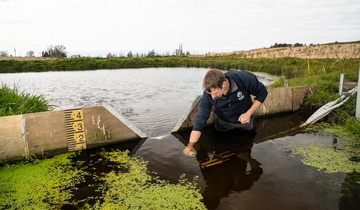This project aims to increase our knowledge of aquatic ecosystems and their restoration, and apply this to degraded streams, rivers, lakes and estuaries.
The problem
New Zealand has a wealth of freshwaters, including rivers, streams, lakes and estuaries. These ecosystems have significant intrinsic values, and also provide for our communities though industry, tourism, culture, mahinga kai, along with having an important place in our personal and national identities.
Much of this resource, however, has been degraded due to the combined effects of wastewater inputs from point sources (e.g., municipal wastewaters) and diffuse sources (e.g., urban and agricultural runoff), habitat alteration (e.g. flow abstraction, riparian deforestation, channelization) and invasive species (e.g., oxygen weeds and coarse fish like koi carp). This degradation builds up until the ecosystems can no longer provide the important services we rely on.
Attempts to reverse this degradation range from harm reduction, through rehabilitation of key ecosystem services to full restoration of pristine conditions, and involve many challenges. Successful rehabilitation or restoration require understanding of: the pressures and stresses that caused ecosystem to degrade; targets for measuring success; time lags in habitat restoration (such as the time for new trees to become established); ecological bottle-necks; legacy effects; and the ecological thresholds for the re-establishment of key species. Contemporary science, traditional ecological knowledge (mātauranga Māori) and local community knowledge each provide complementary information to develop this understanding.
This project will provide knowledge and tools to get the best outcome for time and money invested in mitigation, rehabilitation and restoration.
The solution
This research is developing methods for producing restoration templates, prioritising sites for restoration, and tools and technologies for developing and monitoring the results of restoration activities. It is interdisciplinary, covering riparian, stream, river, lake and estuarine environments; and involves extensive collaboration with a range of end-users, Māori and providers (i.e., NIWA, Otago and Canterbury Universities, Cawthron Institute, Tipa and Associates, Kusabs and Associates). It has a long-term focus incorporating adaptive management (e.g., Whatawhata Sustainable Land Management Project) and predictions at long-time scales. It also utilises engagement with regional councils, iwi, NZ Landcare Trust, and Department of Conservation, and works with end-users to improve the technological learning processes. The programme will provide tools to support aquatic restoration through co-management between Māori and government agencies.
The programme's four objectives are:
1 Values and co-management – we will provide benchmarks, targets and timelines for rehabilitation, real-time and traditional Māori assessment tools, and report cards to support aquatic co-management that link values, indicators and rehabilitation actions.
2 Habitat bottlenecks – we will develop approaches for enhancing bio-complexity and key habitat features (e.g., large wood, seagrass, connectivity) required to boost rehabilitation processes;
3 Critical stages of key species – we are developing ways to overcome the life cycle bottlenecks for key species including mussels, kōura (freshwater crayfish), galaxiid whitebait species, eels, lamprey; and
4 Legacies and eutrophic ecosystems – we are testing chemical, biological and habitat manipulation tools to mitigate nutrient enrichment and manage legacies that constrain restoration (e.g., in-lake phosphorus, willows and mangrove expansion).
The result
The programme has made excellent progress in increasing the knowledge base and developing tools for the restoration of degraded aquatic ecosystems. The first phase between September 2003 and June 2010 produced and disseminated a substantial amount of new knowledge, generating 90 published journal papers and book chapters, 174 talks to conferences or seminars/workshops, 75 popular articles, 66 reports and 4 theses. The first year (to June 2011) of Phase 2 produced another 13 papers, 2 books, 3 popular articles, 69 presentations to conference or workshops and 34 to hui. To consolidate advances, twelve papers and a foreword were published in a special issue of the New Zealand Journal of Marine and Freshwater Research in June 2009 (Vol 43, Issue 3) and a user workshop was run on shallow lake restoration in December 2008.
Shallow lake restoration workshop
Advances include:
- new computer models of fish species distribution
- new methods for targeting rivers and streams for protection
- stream restoration for aquatic invertebrates
- restoration tools for iwi
- engaging stakeholders in developing models of the link between land management and aquatic ecosystems
- the role and use of social research methods in aquatic restoration projects
- combating phosphorus loading in lakes - nutrient inactivation agents
- recolonisation of natural species
- the importance of the riparian zone for reducing pollution
- agricultural stream restoration
- monitoring Koura
- restoration in estuaries
- restoration of native fish in streams
- trout habitat mapping protocol
Outputs
The outputs from this research project are listed in the spreadsheet below. Outputs from Phase 2 to date are also listed below.
RAE outputs 2003-2010 (XLS 152 KB)
RAE outputs 2010 - 2011 (XLS 73 KB)







